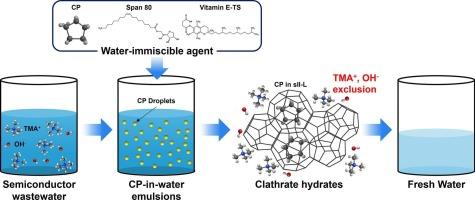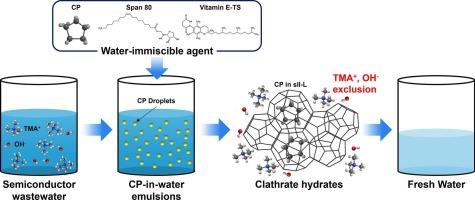表面活性剂稳定的水合环戊烷乳液用于去除半导体废水中的四甲基氢氧化铵
IF 9
1区 工程技术
Q1 ENGINEERING, CHEMICAL
引用次数: 0
摘要
本研究提出了一种创新的水合基废水处理方法,专门针对含有四甲基氢氧化铵(TMAH)的半导体废水,利用非离子表面活性剂Span 80和维生素E-TS稳定的水中环戊烷(CP)乳液。稳定的乳状液显著加快了水合物形成动力学,将诱导时间从313.33 min缩短到约12.67 min(减少了96% %),从而大大提高了过程的能源效率。粉末x射线衍射(PXRD)和拉曼光谱的结构分析证实,浓度为515 mg/L的TMAH分子被有效地排除在水合物结构之外,对水合物的晶体结构和笼状占用没有干扰。此外,加入维生素E-TS作为抗团聚剂促进了多孔水合物结构的形成,将TMAH的去除效率从45.51 %大幅提高到62.96 %,但将水回收率从69.74 %降低到61.64 %。随后的水洗后程序进一步将TMAH去除效率提高到74.88 %,但由于部分水合物熔融,水回收率降低到49.24 %。这些发现强调了平衡水回收和污染物去除效率的重要性,为优化水合物基废水处理工艺提供了重要见解,并突出了其作为半导体废水和其他含有持久性有机污染物的工业废水的节能和可持续解决方案的潜力。本文章由计算机程序翻译,如有差异,请以英文原文为准。


Surfactant-stabilized cyclopentane hydrate emulsions for removing tetramethylammonium hydroxide from semiconductor wastewater
This study presents an innovative hydrate-based wastewater treatment approach specifically designed for semiconductor wastewater containing tetramethylammonium hydroxide (TMAH), utilizing cyclopentane (CP)-in-water emulsions stabilized by nonionic surfactants Span 80 and Vitamin E-TS. The stabilized emulsions significantly accelerated hydrate formation kinetics, reducing the induction time from 313.33 min to approximately 12.67 min (a 96 % decrease), thus greatly enhancing the process's energy efficiency. Structural analyses using powder X-ray diffraction (PXRD) and Raman spectroscopy confirmed that TMAH molecules at concentrations of 515 mg/L were effectively excluded from the hydrate structure, demonstrating no interference with hydrate crystalline structures or cage occupancy. Furthermore, incorporating Vitamin E-TS as an anti-agglomerant promoted the formation of porous hydrate structures, increasing TMAH removal efficiency substantially from 45.51 % to 62.96 %, though reducing water recovery from 69.74 % to 61.64 %. Subsequent post-washing procedures further increased TMAH removal efficiency to 74.88 % but decreased water recovery to 49.24 % due to partial hydrate melting. These findings underscore the importance of balancing water recovery and contaminant removal efficiency, providing essential insights for optimizing hydrate-based wastewater treatment processes, and highlighting its potential as an energy-efficient and sustainable solution for semiconductor wastewater and other industrial wastewater containing persistent organic contaminants.
求助全文
通过发布文献求助,成功后即可免费获取论文全文。
去求助
来源期刊

Separation and Purification Technology
工程技术-工程:化工
CiteScore
14.00
自引率
12.80%
发文量
2347
审稿时长
43 days
期刊介绍:
Separation and Purification Technology is a premier journal committed to sharing innovative methods for separation and purification in chemical and environmental engineering, encompassing both homogeneous solutions and heterogeneous mixtures. Our scope includes the separation and/or purification of liquids, vapors, and gases, as well as carbon capture and separation techniques. However, it's important to note that methods solely intended for analytical purposes are not within the scope of the journal. Additionally, disciplines such as soil science, polymer science, and metallurgy fall outside the purview of Separation and Purification Technology. Join us in advancing the field of separation and purification methods for sustainable solutions in chemical and environmental engineering.
 求助内容:
求助内容: 应助结果提醒方式:
应助结果提醒方式:


